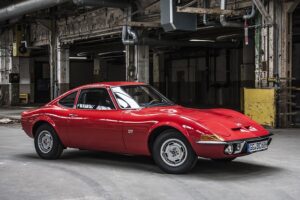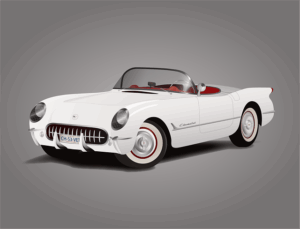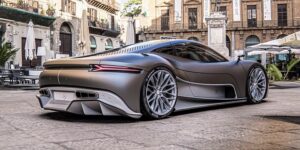Hybrid Cars
Hybrid Cars: A Comprehensive Overview
Introduction
In an era where environmental concerns and technological innovation intertwine, hybrid cars have emerged as a game-changer in the automotive industry. This article aims to take readers on a comprehensive journey through the world of hybrid vehicles, exploring their definition, global impact, economic implications, technological advancements, regulatory landscape, challenges, and promising future prospects. By delving into these aspects, we will uncover the significance of hybrid cars and their role in shaping sustainable mobility.
Understanding Hybrid Cars
Definition and Core Components
A hybrid car is a vehicle that combines two or more sources of power to propel it, typically featuring both a conventional internal combustion engine (ICE) and an electric motor. This innovative design allows for improved fuel efficiency, reduced emissions, and enhanced performance. The core components of a hybrid system include:
- Internal Combustion Engine (ICE): Traditionally powered by gasoline or diesel, this engine operates similarly to those in conventional cars but with advanced technology for better efficiency.
- Electric Motor: A high-torque electric motor provides additional power, especially during acceleration and low-speed driving. It draws energy from rechargeable batteries.
- Battery Pack: High-capacity lithium-ion or nickel-metal hydride (NiMH) batteries store electrical energy for the electric motor’s use. These batteries can be recharged through regenerative braking or by plugging into an external power source.
- Power Control Unit (PCU): This sophisticated electronics system manages the distribution of power between the ICE and electric motor, optimizing performance and efficiency.
- Regenerative Braking System: When the driver applies brakes, the electric motor acts as a generator, converting kinetic energy back into electrical energy to recharge the batteries.
Historical Context and Evolution
The concept of hybrid vehicles dates back to the early 1900s when inventors explored ways to combine internal combustion engines with electric power. However, it was not until the late 20th century that hybrid technology gained significant traction due to growing environmental concerns and advancements in battery technology.
One of the earliest known hybrid cars was the 1972 Toyota Corona, which combined a small gasoline engine with an electric motor and battery pack. This pioneering design paved the way for modern hybrids, leading to breakthroughs in fuel efficiency and emissions reduction. Over time, hybrid technology has evolved, becoming more sophisticated with improved battery life, faster charging times, and enhanced performance capabilities.
Global Impact and Trends
International Influence
Hybrid cars have had a profound impact on global automotive markets, driving innovation and raising environmental standards. Key influences include:
- Environmental Regulations: Stringent emissions standards in regions like Europe and California have prompted automakers to embrace hybrid technology as a means of meeting these requirements.
- Consumer Awareness: Growing awareness of climate change and sustainability among consumers has led to increased demand for eco-friendly vehicles, including hybrids.
- Government Incentives: Many governments worldwide offer tax incentives, rebates, and subsidies to encourage the adoption of hybrid and electric vehicles, fostering market growth.
Regional Trends
The global hybrid car market exhibits diverse trends across regions:
| Region | Market Share (2022) | Growth Rate (2023-2025) | Key Players |
|---|---|---|---|
| Asia Pacific | 45% | 8.5% | Toyota, Honda, Hyundai |
| North America | 30% | 7% | Ford, General Motors, Tesla |
| Europe | 20% | 9% | Volkswagen, BMW, Renault |
| Rest of the World | 5% | 12% (Projected) | Local manufacturers |
Asia Pacific dominates the hybrid market, driven by countries like Japan and China, which have long been at the forefront of hybrid technology development. North America and Europe follow closely, with established automotive hubs leading the way in hybrid innovation.
Economic Considerations
Market Dynamics
The global hybrid car market exhibits a dynamic and competitive landscape:
- Market Segmentation: The market can be segmented by vehicle type (e.g., sedans, SUVs), technology (full hybrid, plug-in hybrid), and battery capacity. This segmentation allows for targeted marketing strategies.
- Price Points: Hybrid vehicles offer a range of price options, from affordable models to luxury variants, catering to diverse consumer segments.
- Sales Performance: Sales of hybrid cars have been steadily rising, with significant year-over-year growth, especially in regions with supportive policies and infrastructure.
Investment Patterns
Automakers and technology companies are investing heavily in hybrid vehicle development:
- Research and Development (R&D): Substantial R&D budgets are allocated to improving hybrid systems, battery technology, and electric motor efficiency.
- Manufacturing Facilities: New production facilities are being established or upgraded to accommodate the manufacturing of hybrid components and vehicles.
- Partnerships: Collaborations between automakers and tech startups drive innovation, enabling the development of advanced hybrid solutions.
Economic Impact
Hybrid cars have far-reaching economic implications:
- Job Creation: The growing hybrid car industry supports numerous jobs in research, manufacturing, sales, and service sectors.
- Supply Chain Growth: A robust supply chain for hybrid components, including batteries, electric motors, and power electronics, has emerged, fostering economic opportunities worldwide.
- Government Revenues: Sales taxes, registration fees, and vehicle emissions-related revenues contribute to government treasuries, impacting fiscal policies.
Technological Advancements
Battery Technology
Battery systems are at the heart of hybrid vehicles’ performance and efficiency:
- Lithium-Ion Batteries: The dominant battery type in modern hybrids, lithium-ion batteries offer high energy density, fast charging, and longer lifespan compared to earlier technologies.
- Solid-State Batteries: Emerging as a game-changer, solid-state batteries promise higher energy density, faster charging times, and improved safety, addressing key limitations of lithium-ion batteries.
- Battery Swapping: Some manufacturers are exploring battery swapping stations, allowing drivers to quickly replace depleted batteries with fully charged ones, enhancing convenience.
Electric Motor Efficiency
Advancements in electric motor technology have led to significant improvements in hybrid systems:
- High-Torque Motors: Modern electric motors deliver higher torque, enabling faster acceleration and improved overall performance.
- Permanent Magnet Motors: The use of permanent magnets in electric motors enhances efficiency and reduces energy losses, resulting in better fuel economy.
- Motor Control Systems: Advanced motor control algorithms optimize motor operation, ensuring efficient power distribution and enhanced vehicle dynamics.
Power Electronics and Computerization
Power electronics and computer systems play a critical role in hybrid vehicles:
- PCU (Power Control Unit): This unit manages the intricate interplay between the ICE, electric motor, and battery pack, optimizing performance and energy conversion.
- Advanced Control Systems: Sophisticated on-board computers monitor vehicle dynamics, driver behavior, and environmental factors to make real-time adjustments for improved efficiency.
- Wireless Connectivity: Some modern hybrids incorporate wireless charging and communication technologies, enabling over-the-air updates and enhanced connectivity features.
Policy and Regulation
Global Regulatory Frameworks
Key regulatory bodies and initiatives shape the hybrid car landscape:
- United Nations (UN) and its Agencies: The UN’s Environmental Programme (UNEP) sets global environmental standards, while the International Energy Agency (IEA) provides guidelines for sustainable mobility.
- European Union (EU): The EU’s strict emissions regulations, such as Euro 6, have driven the adoption of hybrid and electric vehicles across the continent.
- California Air Resources Board (CARB): CARB’s stringent low-emission vehicle (LEV) standards in the US state of California have significantly influenced hybrid technology development.
Incentives and Subsidies
Governments worldwide offer various incentives to promote hybrid car adoption:
- Tax Credits: Many countries provide tax credits or exemptions for purchasing hybrid vehicles, making them more affordable for consumers.
- Rebates: Some regions offer cash rebates or direct payments to buyers of hybrid cars, encouraging early acceptance.
- Subsidies for Research and Development: Governments support R&D in hybrid technology, fostering innovation and cost reduction.
Future Regulatory Directions
The regulatory landscape is expected to evolve further:
- Stricter Emissions Standards: Global efforts to combat climate change will lead to more stringent emissions regulations, pushing automakers towards more advanced hybrid and electric vehicle technologies.
- Infrastructure Development: Governments are investing in charging infrastructure for electric vehicles (including hybrids), addressing range anxiety concerns.
- Data Privacy and Security: As hybrid cars become increasingly connected, regulations focusing on data privacy and cybersecurity will gain prominence.
Challenges and Criticisms
Technical and Performance Issues
Despite significant advancements, hybrid cars face certain challenges:
- Complexity: Hybrid systems are more complex than conventional ICE vehicles, potentially leading to higher maintenance costs and technical issues.
- Performance Trade-offs: While hybrids offer improved performance, especially in urban settings, they may not match the top speeds and acceleration of high-performance ICE cars.
- Battery Degradation: Over time, battery capacity can decrease, impacting vehicle range and performance, requiring proactive management strategies.
Environmental Concerns
Criticisms related to hybrid cars’ environmental impact include:
- Production Emissions: Manufacturing processes for hybrid components, particularly batteries, can generate significant emissions, offsetting some of the benefits during the vehicle’s lifetime.
- Waste Management: Proper disposal and recycling of batteries pose challenges, requiring robust waste management infrastructure.
- Energy Consumption: The energy required to manufacture and recycle batteries raises questions about the overall sustainability of hybrid cars.
Addressing Challenges
Strategies to overcome these challenges:
- Simplifying Hybrid Systems: Researchers are exploring ways to simplify hybrid systems, making them more reliable and cost-effective while retaining core benefits.
- Advanced Battery Technologies: Continued R&D in battery technology is crucial to address degradation issues, improve recycling processes, and reduce production emissions.
- Lifecycle Analysis: Conducting comprehensive lifecycle assessments of hybrid vehicles can help identify areas for improvement and ensure long-term environmental sustainability.
Case Studies: Successful Hybrid Applications
Toyota Prius: Iconic Hybrid
The Toyota Prius, introduced in 1997, is arguably the most recognizable hybrid car globally. Its success lies in combining practical design, efficient hybrid technology, and affordable pricing. With over 4 million units sold worldwide, the Prius has:
- Reduced Carbon Footprint: The Prius has helped reduce global carbon emissions by preventing the release of millions of tons of CO2 from conventional vehicles.
- Driven Hybrid Adoption: Its success has inspired competitors and encouraged automakers to invest heavily in hybrid technology.
- Enhanced Public Awareness: The Prius has contributed to raising public awareness about fuel efficiency and environmental issues.
Tesla Model 3: Electric First, Hybrid Second
Tesla’s Model 3, an all-electric vehicle with hybrid capabilities, showcases the evolution of hybrid technology. As a fully electric car, it offers:
- Impressive Range: The Model 3 has an EPA-estimated range of over 300 miles on a single charge, making it attractive for long-distance travel.
- Instant Torque and Performance: Its electric motor provides instant torque, resulting in swift acceleration and dynamic driving experience.
- Over-the-Air Updates: Tesla’s software updates enable the Model 3 to gain new features and improvements over its lifetime, a unique aspect of modern hybrid/electric vehicles.
Japanese Bus Systems: Efficient Public Transport
In Japan, hybrid buses have revolutionized public transportation, offering:
- Reduced Noise and Emissions: Hybrid buses operate more quietly and emit fewer pollutants than conventional diesel buses, enhancing urban air quality.
- Improved Fuel Efficiency: By optimizing the use of electric motors during city driving, hybrid buses consume less fuel, reducing operational costs for transit authorities.
- Sustainable Urban Mobility: The widespread adoption of hybrid buses contributes to Japan’s reputation as a leader in sustainable urban transportation.
Future Prospects: Hybrid Cars and Beyond
Emerging Trends
The future of hybrid cars looks promising with several emerging trends:
- Plug-in Hybrids: As battery technology advances, plug-in hybrids are gaining popularity, offering the flexibility to drive on electric power for longer distances.
- Solid-State Batteries: The rollout of solid-state battery technologies will significantly enhance hybrid vehicle performance, range, and charging times.
- Autonomous Hybrid Vehicles: With advancements in autonomous driving technology, self-driving hybrid cars could revolutionize mobility, ensuring safer and more efficient transportation.
Strategic Considerations
Automakers and policymakers should focus on:
- Collaborative R&D: Encouraging partnerships between automakers, tech companies, and research institutions to drive rapid innovation and address technical challenges.
- Standardization of Charging Infrastructure: Developing universal charging standards to ensure interoperability and convenience for hybrid vehicle owners.
- Sustainable Battery Recycling: Investing in robust recycling infrastructure to recover valuable materials from used batteries and minimize environmental impact.
Market Growth Areas
Hybrid cars will continue to dominate specific market segments:
- Compact Cars and SUVs: These vehicle types offer efficient and practical solutions for urban commuters, while larger SUVs cater to families seeking fuel-efficient options.
- Commercial Vehicles: Hybrid technology is increasingly being adopted in vans, trucks, and buses, providing sustainable alternatives for last-mile delivery services and public transportation.
- Luxury Market: Premium brands are introducing hybrid variants, combining luxury with sustainability, appealing to environmentally conscious high-end consumers.
Conclusion: Driving Sustainable Mobility
Hybrid cars represent a significant step forward in the evolution of mobility, offering a practical solution to reduce emissions, conserve energy resources, and enhance vehicle performance. With continuous technological advancements, growing global support from policymakers, and increasing consumer demand, hybrid vehicles are poised to play an even more critical role in shaping the future of sustainable transportation.
As we look ahead, the hybrid car market is expected to expand, fostering innovation, creating jobs, and contributing to a greener planet. The journey toward widespread adoption of hybrid and electric vehicles is ongoing, and with each milestone achieved, we move closer to a more sustainable and environmentally friendly automotive industry.
FAQ Section
1. How do hybrid cars save fuel compared to conventional vehicles?
Hybrid cars combine an internal combustion engine (ICE) and an electric motor, allowing them to operate in various power modes. During city driving, the electric motor often takes the lead, relying on battery power and avoiding frequent ICE operation, which is less fuel-efficient. This strategy significantly improves fuel economy in stop-and-go traffic.
2. Are hybrid cars more expensive than conventional cars?
While initial purchase prices of hybrid cars may be higher, they often provide long-term cost savings through improved fuel efficiency and reduced maintenance costs. Government incentives and rebates for hybrid vehicles can also offset the upfront expense. Additionally, lower fuel consumption translates to substantial savings over the vehicle’s lifetime.
3. How do I charge a hybrid car?
Hybrid cars typically have two charging options: plugging into an external power source (similar to electric vehicles) or using regenerative braking to recharge the battery during normal driving. Many modern hybrids support fast charging, allowing drivers to quickly top up their batteries at dedicated stations.
4. Can I drive a hybrid car like a regular car?
Absolutely! Hybrid cars are designed for everyday driving, offering the same level of control and comfort as conventional vehicles. They can be driven in various modes, including pure electric, hybrid assist, or using the ICE alone, depending on speed, terrain, and driver preference.
5. Are hybrid batteries recyclable?
Yes, hybrid car batteries are recyclable, but recycling processes vary by region. Most batteries contain valuable materials like lithium, nickel, and cobalt that can be recovered and reused. Many automakers offer battery recycling programs, ensuring proper disposal and contributing to a circular economy.

Register Car California: VIN Verifier, Document Guide
Looking to register your car in California? This comprehensive guide walks you through the entire process, from understanding key requirements…

Register Car California: Step-by-Step VIN Verification Guide
Looking to register your car in California? This guide walks you through every step, from understanding key requirements to crucial…

Register Car California: DMV VIN Verification Guide
Looking to register your car in California? This comprehensive guide walks you through every step, from understanding crucial requirements to…

Register Car California: DMV VIN Verification & License Plate
Looking to register your car in California? This comprehensive guide walks you through every step, from understanding key requirements to…

Register Car California: VIN Verifier Guide for New Owners
"Learn how to register your car in California with our comprehensive guide. Understanding the state's requirements is essential, starting with…

Register Car California: Step-by-Step with VIN Verification
"Looking to register your car in California? This comprehensive guide will walk you through the entire process, ensuring a smooth…

Register Car California: Step-by-Step Guide to DMV VIN Verification
"Looking to register your car in California? This comprehensive guide breaks down the process step-by-step, ensuring a smooth experience. From…

Register Car California: VIN Verifier & Document Guide
Looking to register your car in California? This guide breaks down the process step-by-step. From understanding key requirements to gathering…

Register Your Car: Step-by-Step Guide with VIN Verifier
Looking to register your car in California? This comprehensive guide walks you through the process, ensuring compliance with state requirements.…

Register Car California: DMV VIN Verifier Guide
Looking to register your car in California? This comprehensive guide walks you through every step, from understanding key requirements to…